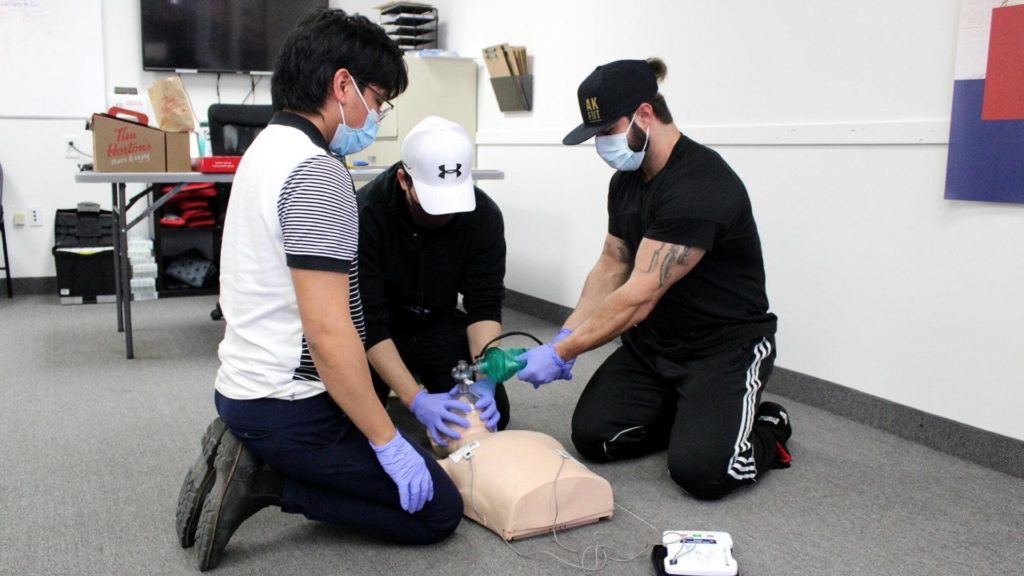Basic Life Support Certification is proof of completing the foundational BLS training. Participants of the BLS course learn the theoretical and hands-on skills required to ensure the best possible patient outcomes in breathing emergencies and cardiac arrest, particularly in fast-paced environments like hospitals and during emergencies. Healthcare professionals, first responders, rescuers, sports doctors, and dentists need BLS certification.
There are several ways Basic Life Support training can impact your career. Besides providing you with the latest life-saving protocols for breathing emergencies, advanced CPR training increases your confidence levels.
For those that are confused, there is a slight difference between BLS and HCP. Basic Life Support training was previously known as CPR-HCP. Certifications expired every three years. In April 2019, the Canadian government required healthcare professionals to update their training on an annual basis. Due to this change, the course is now called Basic Life Support and it provides students more information and skills required for their profession.
Continue reading to find out why healthcare professionals need BLS certification!
What is BLS?
Basic Life Support training provides healthcare professionals and first responders with the skills required to help unresponsive people during breathing emergencies, trauma, etc. The course includes CPR/AED training for all age groups and various other skills.
One of the most common conditions where BLS is required is cardiac arrest. Other cases where the patient is deprived of their vital oxygen supply include choking or drowning. Within a few minutes, a patient can suffer permanent brain damage from a lack of oxygen. In the absence of advanced equipment, BLS training allows healthcare professionals to maximize the chance of a possible outcome for the patient by administering resuscitation and chest compressions as a team.

During the training, participants learn the correct order of CPR and the cycles of CPR.
Expect to learn the following skills in BLS:
- Advanced CPR algorithms (adults, children, and babies)
- Use of an automated external defibrillator (AED)
- Removing airway obstructions in children and adults
- Single and multi rescuer resuscitation
- Use of ventilation devices
- Anaphylaxis
- Trauma
- Opioid emergencies
- Six rights of medication and more!
BLS requires the correct sequence of chest compressions, airway, and breathing, in adults, children, and infants. These components contribute to blood flow and oxygen in life-threatening situations. During training, you learn about the chest compression rate, chest compression depth, chest recoil, and ventilation. You also learn how to perform this in the proper cycles.
Register for First Aid Training
The importance of BLS
Promptly administering advanced CPR can save a person’s life from cardiac or respiratory arrest. Recertifying annually keeps healthcare professionals updated with any new developments.
BLS training teaches students the proper way to administer the life-saving skills required by healthcare professionals and other related industries. These skills are vital for people who offer direct patient care. At Coast2Coast, we offer private/group training for healthcare industry teams; reach out to our customer service reps to find the best option for your needs.

BLS Certification Validity
Basic Life Support certificates remain valid for one year after they are issued. In order to take our Renewal course, you must hold a BLS certificate. Annual retraining ensures that participants retain their confidence and skills. Besides the regular retraining, make sure to get your BLS certificate from an accredited provider such as Coast2Coast First Aid!
Coast2Coast BLS Programs
Coast2Coast has multiple programs to choose from, depending on your work requirements. These are Basic Life Support (HCP), Airway Management & Oxygen Therapy, and Accredited Heart and Stroke Basic Life Support. All the courses teach various life-saving skills, including recognizing cardiac arrest. Participants learn how to respond promptly and confidently, applying the elements of Basic Life Support.
BLS is a 4-hour training course available in morning, afternoon, and evening classes to ensure everyone finds a time slot that suits them. The Basic Life Support and Renewal courses have the same duration, but the Renewal option is offered at a lower rate. If you register for the Renewal, you must bring a copy of your current certificate to class to receive your discount.

Airway Management & Oxygen Therapy is a two-hour intensive training course that provides the skills to offer supplemental oxygen and create an airway when needed. Students learn how to create oropharyngeal, nasopharyngeal, and supraglottic airways in patients. This training also covers the safe handling and assembling of equipment such as oxygen tanks. Oftentimes, this training is taken together with Basic Life Support training by healthcare professionals, first responders, and rescue workers.
Coast2Coast provides Canadian Red Cross Basic Life Support courses in the Greater Toronto Area, Western Ontario, and Eastern Ontario. Learn more about the locations, dates, and times of the various BLS courses HERE.
We hope you’ve learned why healthcare professionals need BLS certification!
Master the Essentials of Life Support!
Join our Basic Life Support (BLS) course and learn critical skills to save lives in emergencies. Our expert instructors will guide you through hands-on training and the latest techniques to help you respond effectively.




















No comment yet, add your voice below!